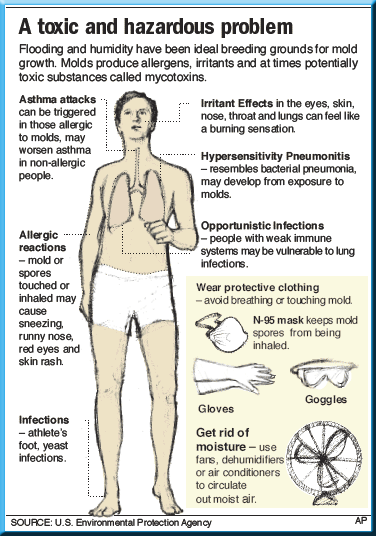Are you curious about how long it takes for symptoms of mold exposure to appear? In this article, we will explore the timeframe and factors that can affect mold-related health issues. Mold exposure can lead to various health problems, but understanding the timeframe between exposure and symptom onset can help individuals take appropriate action to protect their health. By examining the factors that impact mold-related health issues, we can gain a better understanding of how to prevent and manage the effects of mold exposure. So, let’s dive into the details and learn more about the time it takes for symptoms to show up and the factors that influence mold-related health concerns.
Immediate Symptoms of Mold Exposure
Allergic Reactions
If you’ve been exposed to mold, you may experience immediate allergic reactions. These reactions can include sneezing, runny nose, itching, and redness of the eyes. Mold spores can trigger an allergic response in some individuals, especially those who are already prone to allergies. If you notice these symptoms after coming into contact with mold, it’s important to take action and address the issue to prevent further exposure.
Respiratory Issues
Another immediate symptom of mold exposure is respiratory issues. Breathing in mold spores can irritate the respiratory system and cause symptoms such as coughing and wheezing. Some individuals may even experience more severe respiratory problems, such as shortness of breath or difficulty breathing. If you find yourself struggling to breathe or experiencing persistent coughing, it’s crucial to seek medical attention as soon as possible.
Skin Irritation
In addition to allergic reactions and respiratory problems, mold exposure can also cause skin irritation. Contact with mold spores or mycotoxins can lead to itchiness, redness, and rash on the skin. This is because mold releases substances that can be irritating to the skin. If you notice any unusual skin reactions after being exposed to mold, it’s important to wash the affected area thoroughly and consult a healthcare professional if the symptoms persist or worsen.

Short-Term Symptoms of Mold Exposure
Flu-like Symptoms
One of the short-term symptoms of mold exposure is flu-like illness. This can include symptoms such as fever, fatigue, body aches, and headaches. Sometimes, individuals may mistake these symptoms for a common cold or the flu, but if they persist or recur, it could be a sign of mold exposure. It’s important to pay attention to your body and seek medical advice if you experience prolonged flu-like symptoms.
Nasal Congestion
Nasal congestion is another common short-term symptom of mold exposure. This is when the nasal passages feel blocked or stuffed up, making it difficult to breathe through your nose. Mold spores can irritate the nasal passages and cause inflammation, leading to congestion. If you find yourself constantly sniffling or struggling with a congested nose, it’s important to consider mold exposure as a potential cause and take steps to address the issue.
Coughing and Sneezing
Coughing and sneezing are two more short-term symptoms of mold exposure. These symptoms are your body’s way of trying to expel the mold spores that have entered your respiratory system. If you notice that you’re coughing or sneezing more frequently, especially in certain environments or after being exposed to moldy areas, it’s important to take it as a warning sign and investigate the presence of mold in your surroundings.
Eye and Throat Irritation
Mold exposure can also lead to irritation of the eyes and throat. If you’ve been exposed to mold, you may experience red, itchy, watery eyes, as well as a scratchy or sore throat. These symptoms can be bothersome and affect your daily life. It’s crucial to address the underlying cause and take appropriate measures to reduce your exposure to mold to alleviate these symptoms.
Headaches
Headaches can also be a short-term symptom of mold exposure. Mold spores can release volatile organic compounds (VOCs) that can trigger headaches in some individuals. These headaches can range from mild to severe and may be accompanied by other symptoms such as fatigue or dizziness. If you frequently experience headaches in certain environments or after being exposed to mold, it’s important to consider mold as a potential cause and take steps to mitigate your exposure.

Long-Term Symptoms of Mold Exposure
Chronic Sinusitis
One long-term symptom of mold exposure is chronic sinusitis. This is a condition where the sinuses become inflamed and swollen for an extended period, often lasting more than three months. Mold spores can cause irritation and inflammation in the sinuses, leading to persistent sinusitis. Symptoms of chronic sinusitis include nasal congestion, facial pain or pressure, and a reduced sense of smell. If you suspect mold exposure as the cause of your chronic sinusitis, it’s important to consult a healthcare professional for an appropriate diagnosis and treatment plan.
Asthma
Mold exposure can also worsen or trigger asthma symptoms in individuals who are already diagnosed with the condition. Asthma is a chronic respiratory condition characterized by inflammation and narrowing of the airways, making it difficult to breathe. Mold spores can act as respiratory irritants and provoke asthma attacks or increase the frequency and severity of symptoms. If you have asthma and notice an increase in symptoms or find it difficult to control your condition, it’s crucial to consider mold exposure as a possible trigger and take appropriate measures to reduce your exposure.
Fungal Infections
Exposure to certain types of mold can also increase the risk of fungal infections. Inhaled mold spores can settle in the lungs and respiratory tract, providing a breeding ground for fungal growth. This can lead to infections such as aspergillosis or fungal pneumonia. Symptoms of fungal infections can vary depending on the type of infection but may include coughing, shortness of breath, fever, and chest pain. If you suspect a fungal infection due to mold exposure, it’s important to seek medical attention for appropriate diagnosis and treatment.
Mycotoxin Poisoning
Mycotoxins are toxic substances produced by some types of mold. Prolonged exposure to these mycotoxins can lead to mycotoxin poisoning, also known as toxic mold syndrome. Symptoms of mycotoxin poisoning can vary and may include fatigue, headaches, difficulty concentrating, memory problems, and gastrointestinal issues. If you suspect mycotoxin poisoning due to mold exposure, it’s crucial to consult a healthcare professional for proper diagnosis and treatment options.
Neurological Symptoms
In some cases, long-term mold exposure can lead to neurological symptoms. These symptoms may include difficulty concentrating, memory problems, confusion, dizziness, and mood changes. It is thought that mold spores or mycotoxins can directly affect the central nervous system, leading to these neurological symptoms. If you experience persistent or worsening neurological symptoms, it’s vital to seek medical advice to determine the underlying cause and appropriate treatment options.

Timeframe for Mold-Related Symptoms
Immediate Symptoms
Immediate symptoms of mold exposure usually occur within minutes to hours of being exposed to mold spores. These symptoms can include allergic reactions, respiratory issues, and skin irritation. If you notice these symptoms immediately after being in an environment with mold, it’s crucial to address the issue promptly to minimize further exposure and potential health risks.
Short-Term Symptoms
Short-term symptoms of mold exposure typically appear within hours to days after exposure. These symptoms can include flu-like illness, nasal congestion, coughing and sneezing, eye and throat irritation, and headaches. If you experience any of these symptoms after being exposed to mold, it’s important to take them seriously and take appropriate measures to reduce your exposure and seek medical advice if necessary.
Delayed-Onset Symptoms
Some individuals may experience delayed-onset symptoms of mold exposure, which can take weeks or even months to appear. These delayed symptoms can vary widely and may include chronic sinusitis, asthma exacerbation, fungal infections, mycotoxin poisoning, and neurological symptoms. It’s crucial to be aware of these potential long-term symptoms and monitor your health closely if you suspect mold exposure.

Factors Affecting Mold-Related Health Issues
Exposure Duration
The duration of exposure to mold can affect the severity and onset of mold-related health issues. Acute exposure, where a person is exposed to a high concentration of mold for a short period, can cause immediate symptoms. Chronic exposure, on the other hand, refers to prolonged exposure to mold over an extended period. Chronic exposure can lead to long-term health problems that develop gradually over time. Understanding the duration of exposure is important in assessing the potential health risks associated with mold exposure.
Mold Concentration
The concentration of mold in the environment also plays a role in mold-related health issues. High concentrations of mold spores can lead to more severe and immediate symptoms in susceptible individuals. On the other hand, low concentrations of mold may still cause health problems but may take longer to manifest or may affect only individuals with heightened sensitivity. It’s important to ensure proper assessment and remediation measures are taken to reduce mold concentrations and prevent health risks.
Individual Sensitivity
Individual sensitivity to mold varies from person to person. Some individuals may be more prone to allergic reactions or have a genetic predisposition that makes them more susceptible to mold-related health issues. These individuals may experience more severe symptoms or develop health problems sooner than others who are less sensitive. Understanding your own sensitivity to mold can help you take appropriate precautions and seek timely medical attention if needed.
Existing Health Conditions
Existing health conditions can also affect the impact of mold exposure on an individual’s health. Respiratory conditions such as asthma or chronic bronchitis can be exacerbated by mold exposure, leading to more severe symptoms and difficulties in managing the underlying condition. Immune system disorders can also weaken the body’s defense mechanisms and make individuals more susceptible to mold-related infections or mycotoxin poisoning. Additionally, individuals with allergies may experience more intense allergic reactions when exposed to mold. It’s important to consider existing health conditions when assessing the potential risks associated with mold exposure.
Age and Immune Function
Age and immune function can also influence the effects of mold exposure on an individual’s health. Children and infants, whose immune systems are still developing, may be more vulnerable to the adverse effects of mold exposure. They may experience more severe symptoms or be at a higher risk of developing respiratory infections or allergies. Elderly individuals, whose immune function may decline with age, may also experience more severe symptoms or have difficulties in recovering from the health effects of mold exposure. Additionally, individuals with weakened immune systems, such as those undergoing chemotherapy or with certain medical conditions, may be more susceptible to mold-related health issues. It’s crucial to consider age and immune function when assessing the individual’s risk of mold-related health problems.
In conclusion, mold exposure can lead to a variety of symptoms ranging from immediate allergic reactions and respiratory issues to long-term health problems such as chronic sinusitis and neurological symptoms. The timeframe for mold-related symptoms can vary, with some symptoms appearing immediately, while others may develop over time. Several factors, including exposure duration, mold concentration, individual sensitivity, existing health conditions, age, and immune function, can affect the severity and onset of mold-related health issues. It’s important to be aware of these factors and take appropriate measures to minimize exposure and seek medical advice if necessary.
